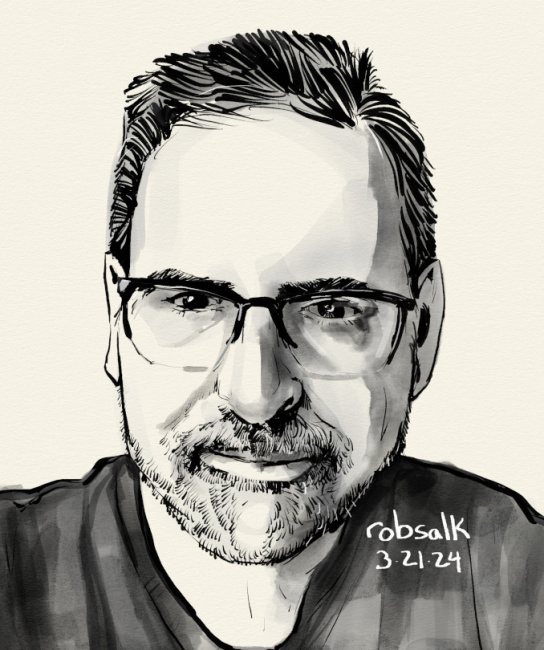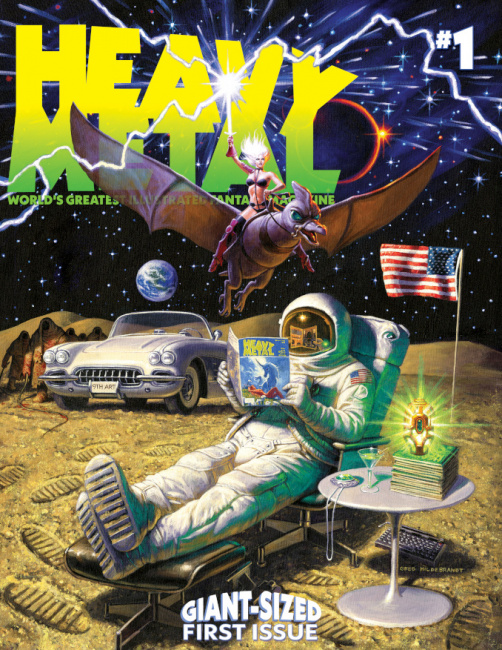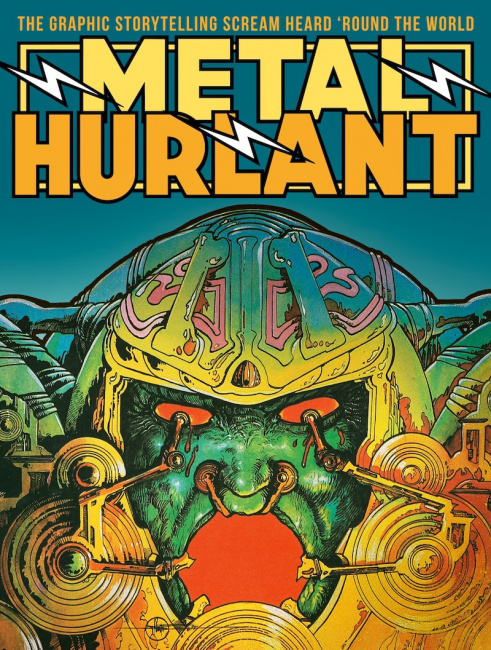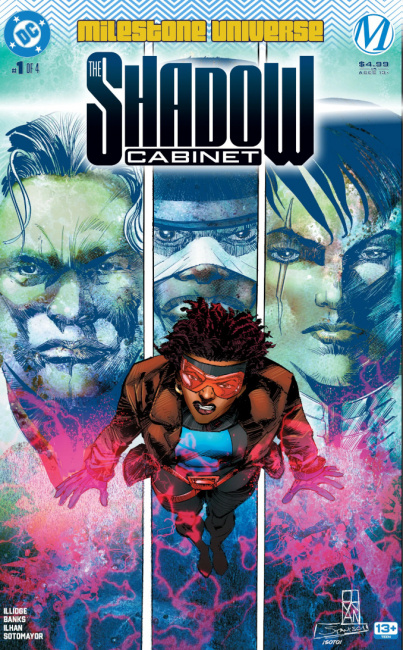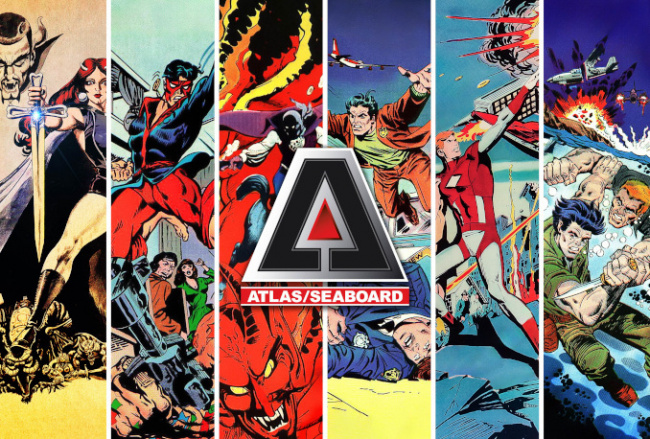Nostalgia ain’t what it used to be, except in the gloriously backward-looking comics industry. After a decade of new companies springing to market full grown like Athena from the head of Zeus, the latest publishing strategy is to bring back venerable brands, whether they are well-remembered or not, to try to recapture moments when comics had some juice.
One more lap on a Moebius strip. One darkly amusing example of this trend is the simultaneous relaunches of Heavy Metal and its European cousin Metal Hurlant, which they never let us forget served as showcases for the work of masters like Moebius, Philippe Druillet, Enki Bilal, Gal and the other great Franco-Belgian bande desinee revolutionaries of the 1970s. I’d wager that not even Marvel gets as much mileage, pound for pound, out of the glow of its foundational work than MH/HM.
Heavy Metal, the better-known imprint in the English-speaking world, is coming back under the editorial stewardship of Dave Kelly, Chris Thompson and Frank Forte, according to CEO Marshall Lees. The team just revealed the cover of the first issue by the recently-deceased fantasy artist Greg Hilderbrandt, featuring familiar totems of the magazine’s glory days and the cult-favorite 1982 animated film, as well as other plans for the relaunch.
Honestly it’s a testament to the enduring affection that (mostly) men of a certain age have for this property, present company included (I was 13 in 1980; what are you gonna do?) that the brand could even consider a comeback before the smell of the recent ignominious revival has left the room (see "ICv2 Interview: Heavy Metal Interim CEO Marshall Lees"). Plenty of creators are still waiting for their checks from that fiasco, which makes asking fans to trust them with a Kickstarter seem a bit rich.
Meanwhile the legitimate heir to all that Euro-sci-fi/fantasy greatness is also crowdfunding its way back to these shores courtesy of original publisher Humanoids (see "Humanoids to Bring Back 'Metal Hurlant'"). The company has been publishing a deluxe, prestige-format Metal Hurlant revival in French for the past several years, combining new and archival comics work with articles and features. You’ve probably seen the promotions featuring Moebius’s iconic Major Grubert from his "Airtight Garage" series. So, fans of sexy robots everywhere, get ready to Kickstart.
The horror, the horror! Earlier this year, the mad scientists at Oni Press reanimated the corpse of another one of comics’ most famed and feared imprints, EC Comics (see "Oni to Launch New EC Comics Line"). Fans with direct experience reading these classics on the stands are now octogenarians, but generations of readers grew up hearing about, and experiencing through reprints, the glorious art and, it must be said, inconsistent and formulaic storytelling of these very tall tales. I don’t think they’ve been out of print in one form or another since the 1980s, with Fantagraphics carrying the banner into the 21st century.
While creators have been aping the style and tone of ECs for nearly half a century, Oni is leaning into the transgressive and subversive quality that the originals had during the dark, repressive days of the 1950s. That’s a good editorial choice, and so far, the work in the two flagship anthology titles Epitaphs from the Abyss and Cruel Universe upholds a standard of quality and creepiness that fans can appreciate.
It's not clear whether the culture still has room for work that challenges social conventions from within the confines of gory horror and spaced-out sci fi stories, but it’s interesting that Oni considers the experiment worth trying.
Back to the 90s at DC. DC seems to have found a groove lately with its All In and Absolute books, but it’s also riding the nostalgia wave. I’m not talking about the "Compact Comics" reprints of classic storylines, although that’s part of it. As you may have heard, DC recently announced the revival of its legendary creator-centric imprint Vertigo, the launchpad for Sandman, Doom Patrol, Fables and dozens of other groundbreaking titles from the 90s and early aughts (see "DC Bringing Back Vertigo").
While I appreciate DC’s efforts to warm the cold, shriveled hearts of my fellow GenXers, it seems like the Vertigo warehouse was ransacked by the likes of Image, Dark Horse, Boom! Studios, DSTLRY, Ahoy and Ghost Machine in the decade since its final glimpse of relevance. Editors Karen Berger, Shelly Bond, Will Dennis and Jamie Rich, who defined the brand’s personality, now work elsewhere, as do most of the marquee creators from the classic era. What remains is a serviceable creator-owned model housed inside a big, big corporate publishing brand, and that ain’t nothing.
One less ballyhooed and perhaps more authentic brand revival at DC also comes from the 90s. Milestone capping off a comeback that began, kind of, in 2020, with Shadow Cabinet, a four-issue miniseries featuring Milestone favorites like Static, Rocket, Icon and Hardware (see "Milestone’s the Shadow Cabinet Team Returns in New Miniseries"). At least this effort features the participation of a couple of legit OGs like Denys Cowan and Joe Illidge, alongside newer creators. The first issue is in stores now.
The weight of the world. One final, kind of weird, addition to this trend I should mention. Remember Atlas Comics? No, not the one that eventually became Marvel. For a minute in the mid-70s, original Marvel publisher Martin Goodman and his son Chip, who were booted from the company when it was acquired by Cadence in the late 60s, started their own revenge project, luring some of the era’s most highly regarded talents like Neal Adams, Steve Ditko, Howard Chaykin, Russ Heath, Alex Toth and Wally Wood. The company is known as Atlas/Seaboard (Seaboard was the magazine publishing arm) to distinguish it from the pre-Marvel imprint of the 1950s.
You could argue that Atlas/Seaboard was about five years ahead of its time, and could have thrived, Eclipse-style, in the early Direct Market era. But it came around in the dying days of the newsstand and never amounted to much, folding after about a year. Even nostalgic affection for characters like "The Brute," "Demon Hunter" (not that one) and "Iron Jaw" is limited due to the surpassing obscurity of the imprint. It’s biggest contribution to present day comics lure is appearing, in disguise, in Alex Segura’s fine prose mystery Secret Identity, which has now been followed with a sequel, Alter Ego, and a comics series spinoff The Legendary Lynx, done in high mid-70s Atlas/Seaboard style by Mad Cave Studios.
It is on this thin reed that a new publishing enterprise has now launched, the one backed by Steven Paul’s SP Media Group in collaboration with retail superbrand Walmart (see "Atlas Comics Revival Starting at Walmart"). You may have seen the booth at the most recent New York Comic Con. Jason Goodman, grandson of Martin, who presided over an attempted revival in 2010, is also involved. One can only wish them better luck the third time around than they had the first two.
Boats against the current. The great American novelist William Faulkner, who never wrote comics as far as I know, once remarked that, in his native Mississippi, "the past isn’t gone, it’s not even past." That has always been true of the comics industry to a greater or lesser extent, but it’s hard to remember a time when so many people are banking on the thrilling brands of yesteryear packing the same entertainment punch that they had back in the day.
The opinions expressed in this column are solely those of the writer, and do not necessarily reflect the views of the editorial staff of ICv2.com.
Rob Salkowitz is the author of Comic-Con and the Business of Pop Culture and a two-time Eisner-Award nominee.
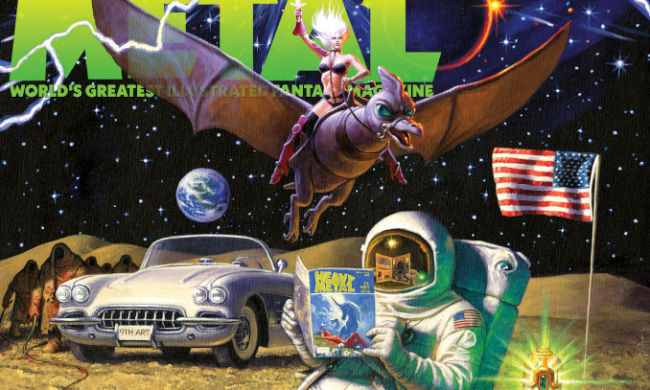
Column by Rob Salkowitz
Posted by Rob Salkowitz on November 25, 2024 @ 4:34 pm CT



